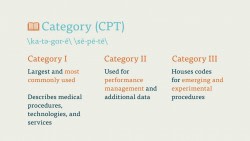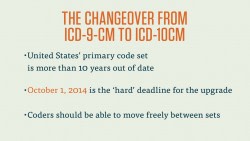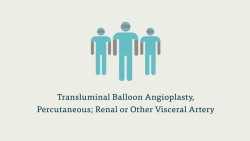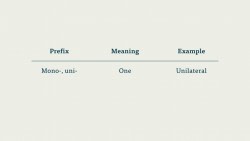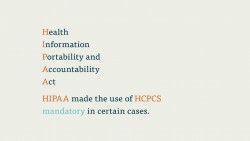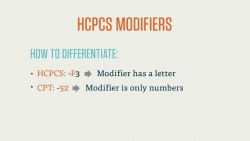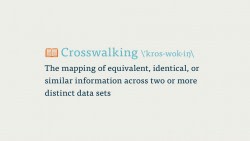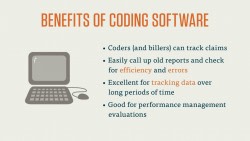Working in medical coding sometimes requires finding equivalencies between different code sets. The code sets CPT, HCPCS, and ICD are updated annually, and medical coders need to know how to find and map codes that may have changed between updates.
To do this, we perform a task called crosswalking. The term ‘crosswalking’ actually comes from computer science. Put simply, crosswalking is the mapping of equivalent, identical, or similar information across two or more distinct data sets. Put another way, when you crosswalk codes, you perform a coding translation between two sets, not unlike how coders translate medical reports into codes in the first place.
Code sets we’re translating between need to both describe the same thing. Bear in mind that crosswalking is not the process of finding the correct diagnosis code for a particular procedure. That’s the demonstration of medical necessity, and it’s an unavoidable part of the coding process. We’ll cover that in a little more depth later on and in our review .
Recommended Online Programs
Most crosswalking is done between two versions of the same code set. That is, a newer version and its older, now out-of-date version. For instance, the AMA updates the CPT code set every year, adding, changing the definitions or descriptions of, and deleting codes. For the most part, CPT and HCPCS make this easy for you by listing deleted and updated codes in appendices in the back of each code manual.
The real crosswalking challenge for the medical coder is between ICD-9-CM and ICD-10-CM. For decades, the ICD-9-CM system was used across U.S. healthcare venues to report diagnoses, but is now out of date and no longer able to effectively represent new medical diagnoses. The current coding system, ICD-10-CM, was implemented on October 1, 2015. This system is significantly larger and more flexible than its predecessor, thanks to its new format.
Crosswalking between ICD-9-CM and ICD-10-CM
To review, ICD-9-CM had five characters and was primarily numeric, with a few alphanumeric codes used in certain situations. ICD-10-CM, on the other hand, is seven characters long and entirely alphanumeric. Where each ICD-9-CM code could have one subcategory and one subclassification, an ICD-10-CM code can have one subcategory and two subclassifications, in addition to an alpha extension that provides information as to which visit, or encounter, this is with the patient’s particular illness or injury. ICD-10-CM is obviously a much more extensive, detail-oriented code set, and its new format and organization presented coders with a challenge during the transition period.
In some cases, coders may still need to translate codes back and forth from one set to the other. If, for instance, you are looking at a patient’s medical history from 2009, it may be necessary to crosswalk those ICD-9-CM codes forward to ICD-10-CM to comply with contemporary coding standards.
The new ICD-10-CM format makes this crosswalking process difficult. Remember, as coders, we always have to be as exact as possible. But because of the increased number of subclassifications, the higher specificity (including ICD-10-CM’s use of laterality and information regarding location on the body), and ICD-10-CM’s organization, less than a quarter of ICD-10-CM codes have an exact match in ICD-9-CM.
So how should we approach the crosswalking process? The best place to start is by breaking down the types of matches there are between code sets. The AMA has classified four types of matches between ICD-9-CM and ICD-10-CM. Let’s take a look at them now.
One-to-One Exact Matches
In these matches, one code set (the source) has an exact match, down to the wording, in the other code set (the target).
One-to-One Approximate Matches with One Choice
Notably more common than exact matchces, approximate matches with one choice make up a majority of the crosswalking procedure. 82.6 percent of ICD-10-CM codes can be crosswalked back to ICD-9-CM as approximate matches with one choice, and 49.1 percent can be mapped in the other direction. Matches like this describe a “close-enough” pairing for two codes.
One-to-One Approximate Matches with Multiple Choices
While exact and approximate matches with only one choice make up the majority of crosswalked codes, coders will occasionally run into coding crosswalks that are less specific. The first of these is an approximate match with multiple choices. In instances of multiple-choice matches, a coder may find two or more options in one code set that correspond to a single code in another set. In situations such as this, it’s up to the coder to decide which of the choices of codes works best for the particular claim.
One-to-Many Matches
This is the most difficult and time-consuming type of ICD-10-CM/ICD-9-CM crosswalk. In one-to-many matches, a code in the source set must be created out of multiple codes in the target set.
In one-to-many matches, a single code in one set must be crosswalked to a “cluster” of codes in the other set. Clusters are always between two and four codes. There may be multiple target clusters for a single source code. It’s up to the coder to look at and abstract all of the concepts in the single source code, and find their corollaries in the target code set. This process of crosswalking by cluster requires diligence and a lot of review, as a missing code from one of the clusters can drastically affect the status of a claim or report.
No Match
In certain cases, there is simply no match between code sets. This typically only happens in cases of crosswalking ICD-10-CM back to ICD-9-CM. In these instances, coders may use the phrase “NoDX” to show that there is no target diagnosis code that matches the source code.
General Equivalency Mappings (GEMs)
Crosswalking between ICD-10-CM and ICD-9-CM became an extremely important skill for coders to learn during the transition period from ICD-9 to ICD-10. In order to help coders, the National Center for Health Statistics created a set of tools, called General Equivalency Mappings, or GEMs. GEMs are like guides that list a code from one set and its exact, possible, or appropriate match in the other set. These GEMs will be maintained for at least three years beyond the October, 2015 ICD-10 implementation date, by the CMS and CDC.
(Like many aspects of the crosswalking process, GEMs can be very intimidating, and they’re difficult to fully understand without a thorough knowledge of the medical coding practice itself. For reasons of brevity and space, we won’t be discussing them in great detail in this course, other than in general terms. If you’d like to learn more about GEMs, how they work, and how to use them, you can find a thorough, comprehensive guide here.)
One of the main things we learn from looking at GEMs is which codes can be transferred from one set to another. One of the main rules of crosswalking is: You can code from a specific injury to a general one, but you cannot code from the general to the specific.
That is, you can’t infer specific pieces of information from a more general diagnosis code and then apply them to a more specific code in another set.
Because crosswalking requires a thorough understanding of both ICD-10-CM and ICD-9-CM, we won’t dive much deeper than that in this course. As you train to become a medical coder, you may be required to take extra courses that instruct you how to map codes effectively between the two sets. Having a fluency in the crosswalking process will make you a more desirable hire.

